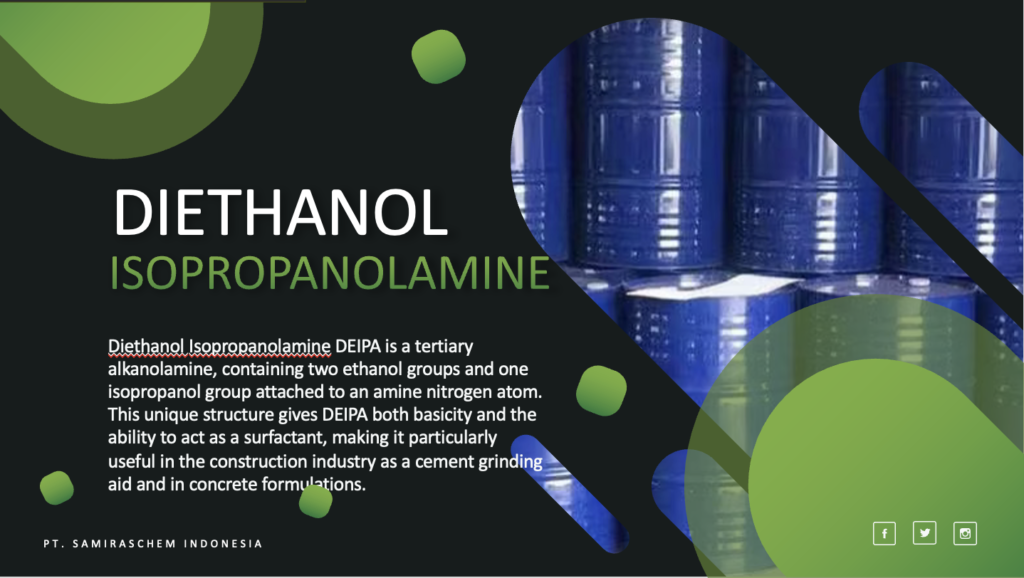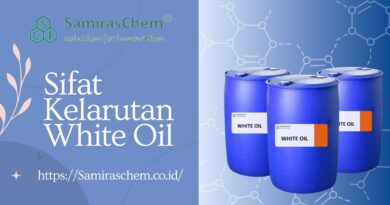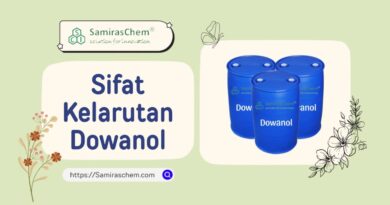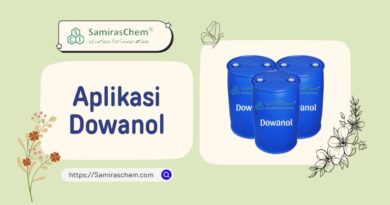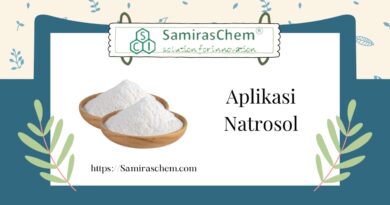Jual Diethanol Isopropanolamine
Jual Diethanol Isopropanolamine DEIPA is a tertiary alkanolamine, containing two ethanol groups and one isopropanol group attached to an amine nitrogen atom. This unique structure gives DEIPA both basicity and the ability to act as a surfactant, making it particularly useful in the construction industry as a cement grinding aid and in concrete formulations.
An Overview DEIPA Jual Diethanol Isopropanolamine
Chemical Formula: C7H17NO3
Molecular Weight: 163.22 g/mol
IUPAC Name: 2-(Diethanolamino)-2-methylpropan-1-ol
1. Chemical Structure and Properties
Jual Diethanol Isopropanolamine has three distinct functional groups—a tertiary amine group and two hydroxyl (alcohol) groups—which together contribute to its properties as a surfactant and basic compound.
- Appearance: DEIPA is a colorless to pale yellow liquid with a mild amine-like odor.
- Boiling Point: Approximately 280°C (decomposes)
- Melting Point: Below -20°C
- Solubility: It is highly soluble in water and soluble in various organic solvents, including alcohols and glycols.
- Density: Approximately 1.05–1.10 g/cm³ at 20°C
- Basicity (pKa): DEIPA is moderately basic due to the nitrogen atom, which can accept protons, forming a positively charged ammonium ion under acidic conditions.
2. Production and Synthesis of DEIPA
DEIPA is synthesized through a reaction between diethanolamine (DEA) and propylene oxide. This reaction proceeds via the addition of propylene oxide to the nitrogen atom in DEA, producing DEIPA as the primary product.
- Reaction of Diethanolamine and Propylene Oxide:(CH2CH2OH)2NH+CH3CHCH2O→CH3CH(OH)CH2N(CH2CH2OH)2
- Purification: The resulting mixture is typically purified to remove any unreacted starting materials or byproducts, such as higher oligomers of propylene oxide.
- Quality Control: DEIPA is further refined and quality-checked to meet specifications for its primary applications in cement and concrete industries.
3. Applications of Diethanol Isopropanolamine (DEIPA)
Jual Diethanol Isopropanolamine is primarily used in the construction industry, especially in cement grinding and concrete production. However, its properties also allow for some other specialized applications:
- Cement Grinding Aid: DEIPA is used as a grinding aid in cement manufacturing, helping to increase the efficiency of grinding mills, reduce energy consumption, and improve the performance of cement. Its use in grinding aids offers benefits such as:
- Enhanced particle dispersion and reduction in particle agglomeration.
- Improved cement hydration, resulting in higher early and ultimate strength of cement.
- Prevention of “cement pack set,” or the tendency of cement powder to clump together.
- Concrete Additive: DEIPA is also used as an additive in concrete formulations to enhance the strength and durability of the concrete. When added to concrete, DEIPA aids in:
- Increasing early compressive strength, especially useful in applications where rapid strength gain is required.
- Improving the workability of fresh concrete, reducing water content needed for a given consistency.
- Enhancing durability by increasing resistance to environmental factors like freeze-thaw cycles and reducing permeability.
- Corrosion Inhibition: Due to its amine-based structure, DEIPA can be used as a corrosion inhibitor in certain applications, especially in concrete exposed to corrosive environments, where it can help protect reinforcing steel in concrete structures.
- Surfactant and Emulsifier: While less common, DEIPA can be used in various formulations as a surfactant or emulsifier due to its ability to stabilize mixtures of water and organic compounds.
4. Benefits of Using DEIPA in Cement and Concrete
Jual Diethanol Isopropanolamine use in cement grinding aids and concrete formulations offers numerous advantages:
- Increased Compressive Strength: Concrete mixtures containing DEIPA tend to achieve higher compressive strength at early ages (24 hours to 7 days), making it ideal for rapid-setting applications.
- Energy Savings: In the cement grinding process, DEIPA can reduce energy consumption by improving grinding efficiency and reducing the required time to reach the desired particle size.
- Improved Concrete Workability: By improving particle dispersion, DEIPA allows for a more uniform and workable concrete mix, which can help reduce water usage or improve the flow properties of the concrete without compromising strength.
- Enhanced Durability: DEIPA-modified concrete has improved resistance to water penetration, chloride ingress, and freeze-thaw cycles, enhancing the lifespan of concrete structures, particularly in harsh environmental conditions.
5. Handling and Storage of DEIPA
Although DEIPA is relatively stable, it requires specific handling and storage measures to maintain its quality and ensure safety.
- Personal Protective Equipment (PPE): Handling DEIPA requires standard PPE such as gloves, eye protection, and, in some cases, respiratory protection if vapors are present.
- Storage Conditions: DEIPA should be stored in a cool, dry, and well-ventilated area, away from strong oxidizing agents and acids. It should be kept in tightly sealed containers to avoid contamination.
- Handling Precautions: DEIPA may react with strong acids or oxidizers, so it’s essential to avoid contact with incompatible materials. Working in well-ventilated areas or using fume hoods is advised to minimize inhalation exposure.
6. Health Hazards and Safety Measures
Jual Diethanol Isopropanolamine like other amine compounds, poses potential health risks if mishandled or in cases of acute exposure.
Acute Exposure: Short-term exposure can cause skin, eye, and respiratory irritation. Inhalation of DEIPA vapors can cause throat and nasal irritation, and ingestion may lead to gastrointestinal discomfort.
Chronic Exposure: Long-term exposure to DEIPA has not been extensively studied, but prolonged skin contact may lead to dermatitis, and repeated inhalation exposure could potentially affect respiratory function.
First Aid Measures:
- Inhalation: If inhaled, move the individual to fresh air immediately. Seek medical help if symptoms like dizziness, coughing, or difficulty breathing persist.
- Skin Contact: Wash the affected area with plenty of water and soap. If irritation persists, seek medical advice.
- Eye Contact: Rinse the eyes thoroughly with water for at least 15 minutes and seek medical attention if irritation continues.
- Ingestion: Rinse the mouth with water. Do not induce vomiting and seek immediate medical attention.
7. Environmental Impact and Disposal Jual Diethanol Isopropanolamine
Jual Diethanol Isopropanolamine can be harmful to aquatic life if released into water sources, and it may contribute to air pollution if allowed to evaporate into the atmosphere. DEIPA’s disposal must follow environmental regulations to prevent environmental contamination.
- Environmental Precautions: Avoid releasing DEIPA into water systems. Any spill should be contained and cleaned up immediately, following guidelines for safe disposal.
- Waste Disposal: DEIPA should be disposed of by licensed waste management facilities or treated according to local environmental protection standards. It can be neutralized and safely disposed of through controlled incineration or chemical treatment, ensuring that it does not pose a hazard to the environment.
PT. Samiraschem Indonesia is Reliable Supplier and Distributor Diethanol isopropanolamine with High Quality Product and Good Price. We are Serving and Delivered Area such Jakarta Bandung Semarang Jogja Surabaya Medan and Batam
Jual Diethanol isopropanolamine (DEIPA) is a valuable compound in the cement and construction industries due to its properties as a grinding aid and concrete strength enhancer. Its surfactant and emulsifying abilities enable it to improve cement grinding efficiency, increase concrete compressive strength, and enhance workability. While it is generally safe to handle with standard precautions, DEIPA requires proper handling, storage, and disposal to ensure both worker safety and environmental protection. Its use contributes significantly to the construction industry, enhancing the performance and durability of cementitious materials.
